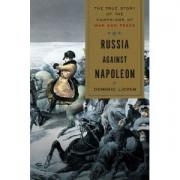In Tolstoy’s theory of history there is no such thing as the Great Man or Leader, no historically necessary commander or practitioner of statecraft. It only “looks like The Great Man ordered things to happen” because he is situated at the head of volitional masses. “The French soldiers at the Battle of Borodino,” wrote Tolstoy, “went to kill and be killed by their own volition; had Napoleon then forbidden them to fight the Russians, they would have killed him and proceeded to fight the Russians because it was inevitable.”

Russia against Napoleon
By Dominic Lieven
Viking
Was Tolstoy correct? Did causation run not from the Great Man to the masses but the other way around? In Russia against Napoleon, Dominic Lieven’s amazing account of the true battles behind War and Peace, his answer is for the most part in the affirmative. He seems to follow modern game theory’s notion that Great Men (leaders) serve as “focal points” in “coordination games.” While it is highly unlikely that an early order of retreat would have caused soldiers of the French army to mutiny and kill their general, it is true, and almost obvious, that herd mentalities prevail in internecine efforts, especially offensive ones. If no one wishes to invade Russia, everyone stays in Paris and practices drills. But if all your fellow combatants are marching to Moscow, you read this “indeterminacy” (game theory again), this choice, as really being almost no choice at all —you want to be part of it, to make your life a part of the world.
Lieven would have it that within the “coordination game” of war, there are not so much Great Men as lesser commanders whose idiosyncrasies of character and appeal can galvanize groups, given the right timing and territorial opportunities. Accordingly, even though the Russian czar Alexander I appointed Mikhail de Tolly to lead his army, the soldiers were not inspired until the much more mundane “other Michaels” Kutisov and Miladorovich—“people’s” generals and Russian to the core—came forward to rally the dispirited troops who had clearly been outsoldiered by Napoleon’s fierce infantry.
The Great Man, France’s undisputed military genius, had half a million men following him across the Russian frontier. But as Lieven’s fascinating logistical analyses show, one flank of the army—numbering 120,000 men and 40,000 horses—needed 850 carts to carry a single day’s supply of human foodstuffs and livestock forage. Napoleon’s mistake, besides underestimating the harsh weather and stubborn peasants of Russia, was not grasping the sheer impossibility of transporting enough food and fodder to supply his units across the vast terrain he was invading. Lieven’s explanations of the practicalities of preindustrial warfare will, believe it or not, keep you on your seat’s edge. Never had so ambitious an endeavor been launched: the French commanders, however better trained, needed to bring an impossibly large part of their country with them a thousand miles from their bases.
In this the Russians thwarted them at every turn. Enter the “Little Men” center stage, the true “focal points” of the terrible indeterminacy of both 1812 and 1813. Russian generals like Kutuzov, Miloradovich, the devilish, near-mythical cavalry genius Vasilchikov, and author Lieven’s own ancestor Johan van Lieven—all of them knew they were doomed in pitched battles with the French. Accordingly, and as Lieven shows by writing from a beautifully Russian perspective (he titles the Napoleonic retreat chapter “The Advance from Moscow”), the Russians fought a Fabian war of attrition, hiding behind redoubts, surrounding scattered regiments with pincer movements, burning and looting supply batteries, and slaughtering thousands of irreplaceable French horses and cart mules.
Then came the true secret weapon: the stealth drones of early nineteenth-century Asiatic ground combat. These were, of course, the Cossacks. Perfectly fitting into (and sometimes leading) Russia’s already superior light cavalry units, these ethnic bands were bred to irregular warfare, the guerrilla fighters of the steppes and marshes. Groomed from infancy to be brilliant horsemen and adept with a variety of weapons, they were able to outmaneuver any French rider and shoot from all positions in the saddle, or from behind the flank of what appeared to be an empty horse. Like Hitler’s with the snipers of the Siberian Rifles, Napoleon’s hatred of the Cossacks was motivated mainly by jealousy: if only he had gotten to these historical mercenaries first! Yet it was French peasants who betrayed the undersized general: they were the chief sources of the Cossacks’ intelligence briefings.
Though Napoleon didn’t really “lose” at Borodino—it was a fight to the draw—he was so utterly battered that the subsequent six weeks in Moscow had his formerly stalwart cavalry wandering about like ghosts, foraging for food, new horses, boots and tunics, and the still-working weapons of both French and Russian casualties. Napoleon had started his campaign with 450,000 men. Rotskoi and Fere-Champenoise’s great paintings of the inevitable retreat from Moscow show it all: only 6,000 men left, many of them dying of exhaustion and starvation as they marched. Le Grande Armée was in its death agony, thrashing in the snow, staining it crimson.
Lieven gives us an appropriate coda in his descriptions of the revitalized czar’s continuing 1813–14 battles with Napoleon in central Europe, tearing Prussia and Austria away from their French alliance, dislodging Sweden from its neutrality, and decisively defeating (in the battles of Kulm and Leipzig, aka “the Battle of the Nations”) what was left of the diminished Gallic armies. These were the two final nails in Napoleon’s coffin; within months, the empire began to disintegrate.
Lieven has everything we could ask of a historian: intricately rendered but never suffocating detail; mastery of strategy and logistics; subtle appreciations of the role of geography and weather; and more than anything else, the ability to show extremely pressured personalities reacting to the sometimes surprising, often truly accidental spotlight of opportunity. And writing from a Russian perspective, looking from East to West, Professor Lieven affords us English-language readers an old, overwritten story freshly made, utterly original in its point of view. When the philosopher Hegel looked out his Vienna office window and saw Napoleon on his white steed prancing down the cobbles of the Ringstrasse, he felt he was seeing “the World-Spirit come at last to its embodiment in flesh and mind.” Time would show that he was witnessing a being full of vanity, misplaced exuberance, and a propensity for error that the Little Men, always on his flank, riding always beside him, and circling like vultures, would expand into all-out catastrophe.


